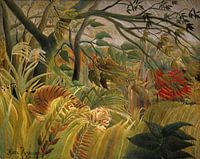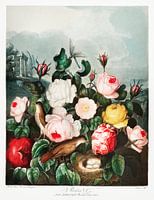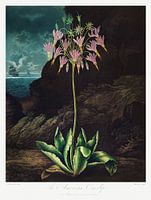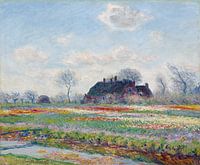Buy this painting Santa Prassede by Felice Ficherelli. Bardi-Serzelli version. Digitally enhanced version. by Frank Zuidam as a reproduction on canvas, ArtFrame, poster and wallpaper, printed on demand in high quality.
About "Santa Prassede by Felice Ficherelli. Bardi-Serzelli version. Digitally enhanced version."
by Frank Zuidam
About the artwork
This painting of Saint Praxedis would appear to be the prime version of the composition, which is known primarily in two other variants. One is another autograph version by Felice Ficherelli, which was formerly in the collection of Carlo del Bravo in Florence, and is now in a private collection in Ferrara (oil on canvas, 108 x 80 cm, see fig. 2), and the other is the celebrated copy of the composition which has been given to Johannes Vermeer (Delft 1632-1675), and was sold recently at Christie’s, London. (oil on canvas, 101.6 x 81.6 cm., 8 July 2014, lot 39, for € 7.900. 000, see fig. 1). Both these two versions were exhibited recently in Rome (see literature). Vermeer’s Saint Praxedis was hung alongside the del Bravo Ferrara version, which has been widely considered to be the prototype and the model for Vermeer’s painting. However, it is possible that another version of the composition might have served as the actual model.
Arthur Wheelock believes that the version of this composition copied by Vermeer is his earliest dated work and an exploratory painting by a young artist who had recently converted to the Catholic faith and who had a proven interest in contemporary Italian art (see A. K. Wheelock, St. Praxedis: New Light on the Early Career of Vermeer in: Artibus et Historiae, vol. 7, no. 14, 1986, pp. 71-89). The present composition must have exerted a strong impact on Vermeer, not just on artistic grounds, but also on account of its devotional character.
Vermeer would have had access to Italian paintings, even if he did not visit Italy itself, but it must be asked why he decided to copy a composition by Ficherelli. The possibility always exists that he was commissioned to paint it. Even if he were not, the subject may have had a special appeal for him as St. Praxedis was one of a number of Roman saints who enjoyed a popularity among Jesuits of the seventeenth century as they sought to emphasise the early traditions of the Catholic Church. Vermeer’s interest in Jesuit ideas at the time must have been acute. Although he had been baptised in the Reformed Church, he married into a Catholic family in 1653 and seems to have converted to Catholicism shortly before that date. He named his youngest son Ignatius and had ties with the Jesuits throughout his life. The subject of Saint Praxedis

About Frank Zuidam
Welcome to my store. I'm Frank. Feel free to look around. Here you will find paintings, t-shirts, stickers, my best photos and more.
You can find more photos on my Instagram. Let me know if I can make something special for you!
Thanks for visiting!..
Read more…
 Germany
Germany Ordered in March 2019
Ordered in March 2019
 Germany
Germany Ordered in March 2020
Ordered in March 2020
 Netherlands
Netherlands Ordered in May 2020
Ordered in May 2020
 Netherlands
Netherlands Ordered in June 2019
Ordered in June 2019
 Germany
Germany Ordered in November 2021
Ordered in November 2021
 Netherlands
Netherlands Ordered in April 2020
Ordered in April 2020
 Germany
Germany Ordered in November 2020
Ordered in November 2020
 Netherlands
Netherlands Ordered in May 2018
Ordered in May 2018

 Netherlands
Netherlands Ordered in November 2019
Ordered in November 2019
 Netherlands
Netherlands Ordered in December 2021
Ordered in December 2021
 Netherlands
Netherlands Ordered in June 2021
Ordered in June 2021
 Netherlands
Netherlands Ordered in March 2024
Ordered in March 2024
About the material
ArtFrame™
Interchangeable Art Prints
- High-quality print
- Easily interchangeable
- Acoustic function
- Large sizes available
Discover the artworks of Frank Zuidam
 Exotic landscape, 1908 by Henri Rousseau.Frank Zuidam
Exotic landscape, 1908 by Henri Rousseau.Frank Zuidam Henri Julien Rousseau Mandrill in the Jungle Henri RousseauFrank Zuidam
Henri Julien Rousseau Mandrill in the Jungle Henri RousseauFrank Zuidam Traumgarten by Henri Rousseau.Frank Zuidam
Traumgarten by Henri Rousseau.Frank Zuidam View of the bridge in Sèvres by Henri RousseauFrank Zuidam
View of the bridge in Sèvres by Henri RousseauFrank Zuidam Boy on the rocks, 1895-1897, by Henri Rousseau.Frank Zuidam
Boy on the rocks, 1895-1897, by Henri Rousseau.Frank Zuidam Tiger in a Tropical Storm by Henri RousseauFrank Zuidam
Tiger in a Tropical Storm by Henri RousseauFrank Zuidam A Creek in St. Thomas (Virgin Islands) by Camille Pissarro. Digitally enhanced version.Frank Zuidam
A Creek in St. Thomas (Virgin Islands) by Camille Pissarro. Digitally enhanced version.Frank Zuidam Katsuyama Neighborhood (ca.1929–1932) by Hiroaki Takahashi.Frank Zuidam
Katsuyama Neighborhood (ca.1929–1932) by Hiroaki Takahashi.Frank Zuidam Fine Wind, Clear Morning by Katsushika Hokusai'sFrank Zuidam
Fine Wind, Clear Morning by Katsushika Hokusai'sFrank Zuidam Tulips from The Temple of Flora (1807) by Robert John Thornton.Frank Zuidam
Tulips from The Temple of Flora (1807) by Robert John Thornton.Frank Zuidam Cupid Inspiring plants with love from The Temple of Flora (1807) by Robert John Thornton.Frank Zuidam
Cupid Inspiring plants with love from The Temple of Flora (1807) by Robert John Thornton.Frank Zuidam Large–Flowering Sensitive Plant from The Temple of Flora (1807) by Robert John Thornton.Frank Zuidam
Large–Flowering Sensitive Plant from The Temple of Flora (1807) by Robert John Thornton.Frank Zuidam The Pontic Rhododendron from The Temple of Flora (1807) by Robert John Thornton.Frank Zuidam
The Pontic Rhododendron from The Temple of Flora (1807) by Robert John Thornton.Frank Zuidam Hyacinths from The Temple of Flora (1807) by Robert John Thornton.Frank Zuidam
Hyacinths from The Temple of Flora (1807) by Robert John Thornton.Frank Zuidam Roses from The Temple of Flora (1807) by Robert John Thornton.Frank Zuidam
Roses from The Temple of Flora (1807) by Robert John Thornton.Frank Zuidam The Quadrangular Passion Flower from The Temple of Flora (1807) by Robert John Thornton.Frank Zuidam
The Quadrangular Passion Flower from The Temple of Flora (1807) by Robert John Thornton.Frank Zuidam The Persian Cyclamen from The Temple of Flora (1807) by Robert John Thornton.Frank Zuidam
The Persian Cyclamen from The Temple of Flora (1807) by Robert John Thornton.Frank Zuidam The American Cowslip from The Temple of Flora (1807) by Robert John Thornton.Frank Zuidam
The American Cowslip from The Temple of Flora (1807) by Robert John Thornton.Frank Zuidam Claude Monet's Tulip Fields at Sassenheim (1886)Frank Zuidam
Claude Monet's Tulip Fields at Sassenheim (1886)Frank Zuidam Sanka Hakuu by Katsushika Hokusai (1760-1849),Frank Zuidam
Sanka Hakuu by Katsushika Hokusai (1760-1849),Frank Zuidam













 Serene Peace
Serene Peace









